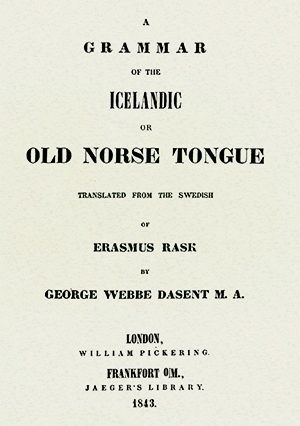THE Makt Myrkranna Translation Project: Source and MethodMy translation is based on the text of the installments published in the Icelandic magazine Fjallkonan (13 January 1900 - 20 March 1901), which is identical with the text of the 1901 hardcover edition, except for the extra chapter of 13 October 1900, which was omitted from the 1901 edition and the 2011 republication. The latter is almost identical with the 1901 edition, with some minor text deviations, and the use of “s” instead of “z” in words like “sízt” (1901) vs. “síst” (2011), “helzt” vs. “helst”, “brezka” vs. “breska”, “ţyzku” vs. “ţysku”, etc. Although Icelandic has its linguistic roots in common with my regular working languages, Dutch, English and German, it has retained a highly complicated system of declension and inflections, with numerous irregular forms. And although it is still very similar to the Old Norse, allowing most Icelanders to read the sagas created around 1300 AD without any problems, its vocabulary has slightly shifted since 1900, when Makt Myrkranna was first published. Moreover, Ásmundsson, who had a thorough knowledge of Icelandic folklore, incorporated several elements of his country’s popular belief into this adaptation, like giant trolls, seductive Elven Queens, ominous fylgja (shadow spirits), fortune-promising haugeldar (flames appearing on burial mounds) and other supernatural appearances. For all these reasons, I decided to co-operate with a group of native Icelandic speakers with various professional backgrounds from all over the world. These include languages, literature and ethnology, but also architecture, medicine, psychology, pharmacology, optics, chemical engineering, business management, tourism, sports, shipping, horse breeding, music and dance, allowing all aspects touched upon in the story to be covered. Our Icelandic-language Editing Team is presented in our TEAM section. Here you will also find more information about our English-language Editing Team, which transcribed the literal translation to a more fluent and natural English. For an in-depth check on pre-modern Icelandic expressions, not listed in modern Icelandic-English dictionaries anymore, I consulted, among others:
This way, the meaning of some terms from the 19th century, which today have passed into oblivion, could indeed be reconstructed. For many background questions, such as Icelandic myths and legends, daylight hours in Reykjavík and Transylvania, the love affairs of Josephine de Beauharnais, the reception of Icelandic literature in Britain, etc., dozens of specialized publications were consulted. |
||
|
A
Grammar of the Icelandic or Old |
Icelandic-English
Dictionary, based on the |
Icelandic
translation of 1001 Nights |
|
Altogether, the process of translating, annotating, editing and background research took more than two years. The result is an enrichment for the understanding of both Bram Stoker's and Valdimar Ásmundsson's work, and of Gothic literature in general. |
||



